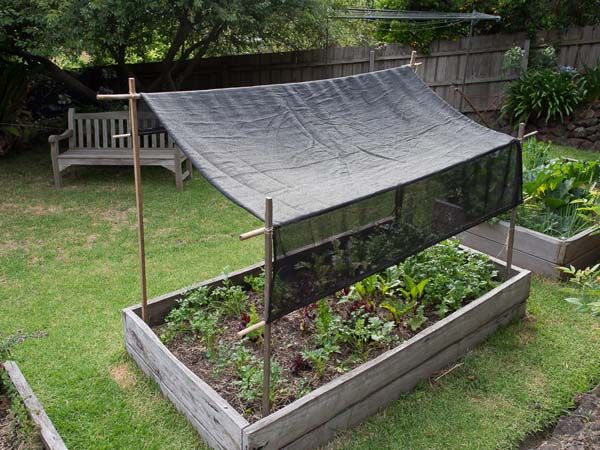Do your vegetable or flower beds bake in the hot summer sun? While many plants thrive in full sun, too much direct sunlight can wilt, scorch or stunt some varieties. Providing strategic shade allows you to grow a wider diversity of plants successfully.
Shading your beds can also help retain soil moisture, protect pollinators, and prevent bolting in cool-season crops. Follow these 12 techniques to add flexible shade solutions to your raised garden beds.
Reasons to Add Shade over Raised Beds
Before jumping into shading methods, let’s review the key benefits:
Prevents scorching – A reprieve from intense midday sun keeps delicate leaves and blooms from wilting or burning.
Retains moisture – Shade reduces evaporation, helping soil stay evenly moist between waterings
Protects pollinators – Bees and butterflies need places to cool down on hot days. Shade offers them a safe haven.
Keeps plants from bolting—Too much sun makes plants like lettuce and kale bolt too soon. A little shade keeps them growing.
Lowers the temperature of the soil—shaded soil stays cooler, which helps roots work better on hot days.
Allows different kinds of plants—Adding shade lets you grow types that would struggle in full sun.
Temporary Shade Solutions for Raised Beds
When shade needs are short-term, opt for removable shade structures:
-
Umbrellas – Place tall patio umbrellas near beds to instantly block sunlight.
-
Window screens – Drape old window screens over frames to diffuse harsh light.
-
Sheets or burlap – Use clothespins to secure fabric over sensitive plants as needed.
-
Shade cloth – Drape various densities of shade cloth that reduce light 30-80%.
-
Bed sheets – Weigh down light bedsheets over plants with bricks or stones for temporary shade.
-
Paper shades – Make cones from paper or cardboard to shade individual plants when necessary.
Seasonal Shade Structures
For shade needs lasting weeks or months, try these season-extending structures:
-
PVC hoops – Bend PVC pipes over beds and cover with shade fabric as needed in summer.
-
Wood lath panels – Hinge together 1×2″ wood lath panels to angle shade down onto beds as desired.
-
Lumber frames – Build open-topped rectangular frames from 2×2″ lumber to support shade cloth over sections of garden.
-
Cold frame lids – Place spare glass cold frame lids atop raised beds to allow air flow while filtering harsh sun.
Permanent Shade Solutions
For ongoing shade in key areas, incorporate permanent structures into your garden plan:
-
Shade sails – Hang triangular fabric sails from posts or beams to block sun while allowing breeze.
-
Gazebos – Build or install open-sided gazebos over part of your garden space to limit light.
-
Arbors – Create shaded tunnels down center paths or across beds with wood or metal arbors.
-
Lattice – Use lattice panels, shade screen or slatted fencing on sides or tops of beds needing shade.
-
Trees – Strategically place trees, shrubs or vines around the garden to cast shade where it’s needed most.
Ideal Plants for Partially Shaded Raised Beds
Once you’ve added shade, make the most of it by selecting plants suited to partial sun conditions:
Cool Weather Crops – Lettuce, kale, chard, carrots, beets, broccoli, peas
Leafy Herbs – Mint, parsley, cilantro, arugula, mache, oregano, basil
Edible Flowers – Nasturtiums, violas, borage, calendula, sage
Chard & Kale – Rainbow chard, red kale, walking-stick kale
Peas & Beans – Snap peas, soybeans, yard-long beans
Berry Bushes – Gooseberries, currants, blueberries
Get creative mixing sun-lovers with shade-tolerators to make the most of dappled light conditions in your raised beds!
Key Tips for Shading Raised Garden Beds
Follow these guidelines as you add shade elements to your raised bed setup:
-
Shade beds from late morning to early afternoon when sun is most direct overhead.
-
Use at least 30% shade cloth density for meaningful protection. 50% is ideal for delicate plants.
-
Water shaded beds 1-2 days longer between watering as soil dries out slower.
-
Monitor for pests like slugs and snails that prefer shady, moist areas.
-
Refresh mulch before summer to keep soil cooler under shade structures.
-
Avoid permanent structures that will shade beds year-round – adjust seasonally.
Get creative combining temporary and permanent shade solutions to control just how much sun reaches each part of your growing space. A thoughtful shade strategy allows you to customize conditions bed-by-bed.
Get Expert Guidance Adding Shade to Your Garden
The possibilities are endless when it comes to adding shade over your raised beds. If you need guidance customizing shade solutions for your unique space and conditions, I can help. From shade cloth tents to gazebos and beyond, let’s explore options to protect your plants while supporting your garden style and budget. With smarter shade, you can grow happier, healthier plants!
Cheapest & Easiest Garden Shade Cloth
FAQ
Do raised garden beds need shade?
How to protect raised garden beds from sun?
How do you add shade to a garden bed?
What is the best sun shade for a vegetable garden?
- The Ultimate Guide to Growing Strawberries in Raised Beds - August 8, 2025
- No-Dig Garden Beds: The Easiest Way to Grow a Beautiful Garden - August 6, 2025
- How to Protect and Preserve Wood for Raised Garden Beds - August 6, 2025

